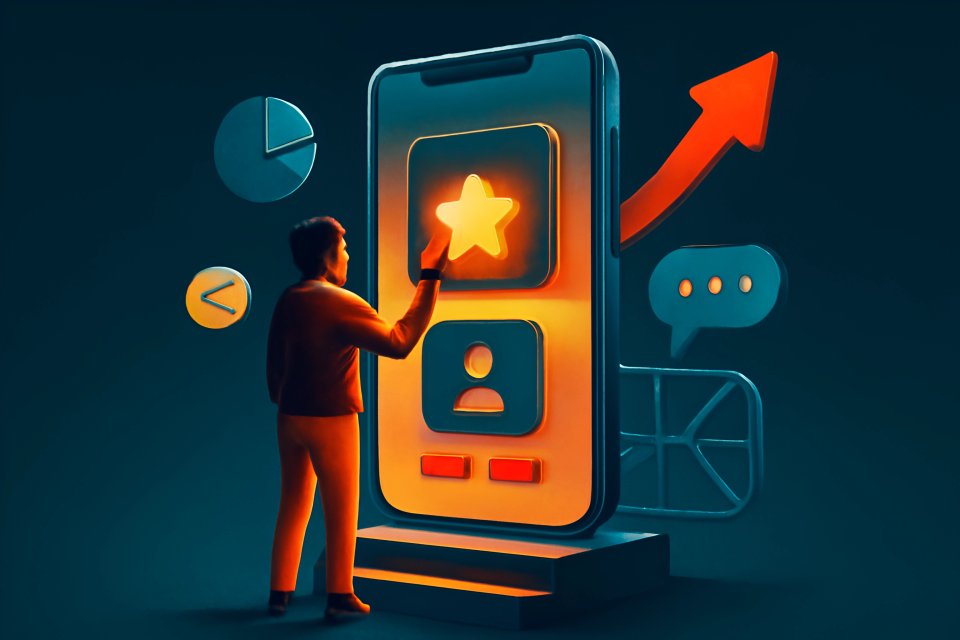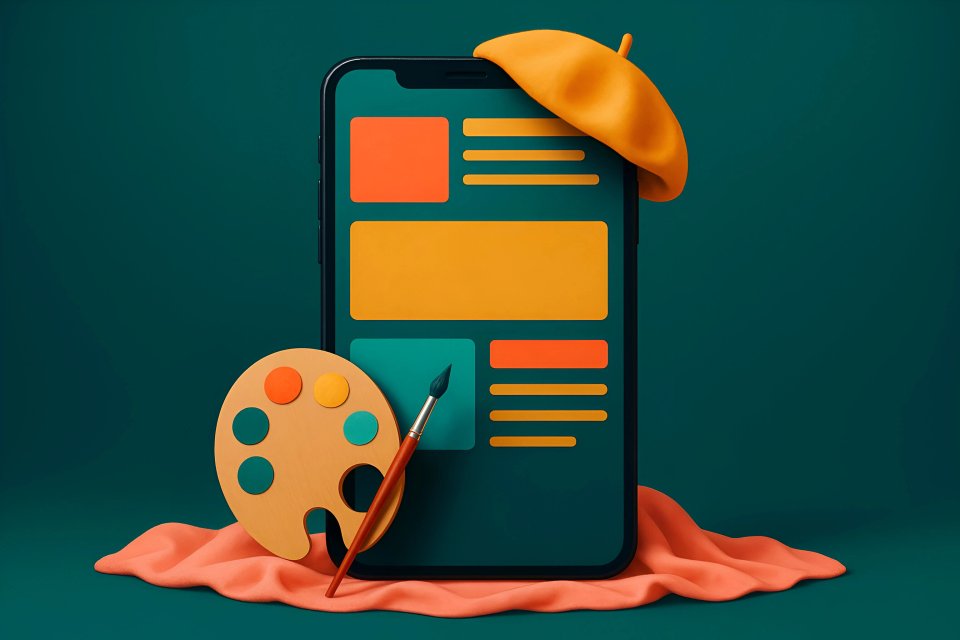Have you ever downloaded an app, opened it once, and never touched it again? You’re not alone. A staggering 25% of users abandon a mobile app after only one use. In a digital world overflowing with options, a great idea and a functional app are no longer enough to survive, let alone thrive.
The real battle isn't for downloads; it's for attention. It's for loyalty. The chasm between an app that's merely used and one that's truly loved is bridged by a single, powerful force: user experience. The old, cookie-cutter design templates simply won't cut it anymore if you want to win.
This is where we move beyond the basics. We will explore the cutting-edge, innovative UI/UX design strategies for mobile app development that grab users by the heart, command their attention, and turn fleeting curiosity into fierce loyalty. At CaptivateClick, we've built our 15-year legacy on a core belief: the most dominant apps are born at the intersection of breathtaking design and relentless user engagement.
Why a Deeply User-Centric Approach is the Bedrock of High Engagement Mobile App Design Techniques
Stop thinking "user-friendly." That's table stakes. The new frontier is user-centric, a radical shift in perspective that separates the good from the unforgettable. Being user-friendly means your app is easy to use; being user-centric means your app feels like it was built just for them, anticipating their needs, contexts, and even their emotional state.
This deep understanding isn't guesswork; it's a science. It begins with non-negotiable foundational work like crafting detailed user personas and empathy maps. These tools force you to walk in your users' shoes, to feel their frustrations and celebrate their wins, ensuring every design choice is rooted in genuine human insight.
From there, you map their entire journey, identifying every critical touchpoint. Did you know that users who complete onboarding in under a minute show 50% higher retention rates? This is the kind of data-driven empathy that transforms an app from a simple tool into an indispensable part of a user's life, a principle we explore in our guide to crafting intuitive mobile app UI/UX designs.
Strategy 1: Hyper-Personalization & Contextual Interfaces
The Concept
Forget just using a first name in a notification. True hyper-personalization means creating a dynamic, living interface that shapeshifts based on user behavior, location, time of day, or past purchases. It’s an experience that says, "I know you. I get you. And I'm here to make your life easier."
The Engagement Impact
This isn't just a feature; it's a powerful psychological trigger. It creates a bespoke mobile app user experience that feels deeply intuitive and uniquely valuable, slashing friction and making your app feel like a trusted confidant. When an app consistently delivers exactly what a user needs before they even ask, it builds an unbreakable bond of trust and reliance.
In Practice
Look at Spotify's "Discover Weekly" or a travel app that automatically shows you flight deals for your favorite destinations. These aren't lucky guesses; they are calculated, data-driven experiences. With 77% of consumers actively choosing brands that offer personalized experiences, this strategy is no longer an option—it's a requirement for market dominance.
Strategy 2: The Power of Microinteractions and Haptic Feedback
The Concept
What makes an app feel truly premium? It's the little things. Microinteractions are the small, purposeful animations and responses that acknowledge a user's action—the satisfying "pop" of a liked photo, the subtle vibration on a form submission, or the smooth transition of a menu sliding into view.
The Engagement Impact
These details are the soul of your UI. They provide instant, gratifying feedback, guide the user's eye, and inject a dose of personality that makes the app feel responsive, polished, and alive. An app with thoughtful microinteractions feels less like a cold piece of software and more like a dynamic conversation, a principle that boosts engagement by as much as 40% by reducing cognitive load.
Best Practices
The key is purpose. Every animation and vibration should serve a function, whether it's confirming an action, preventing an error, or simply adding a moment of delight. These details must be subtle, lightning-fast, and perfectly aligned with your brand's identity, turning simple taps and swipes into a rewarding tactile experience.
Strategy 3: Advanced Gamification and Motivating User Journeys
The Concept
Move beyond meaningless badges and points. Sophisticated gamification taps directly into our primal desires for achievement, status, and competition. Think powerful motivators like daily streaks, progress bars for completing complex profiles, and community leaderboards that ignite a user's competitive spirit.
The Engagement Impact
This is how you turn mundane tasks into addictive challenges. By framing the user journey as a game to be won, you create powerful emotional hooks that keep them coming back for more. It transforms app usage from a chore into a rewarding quest for mastery and social recognition.
In Practice
Duolingo's learning streaks masterfully use the fear of loss to drive daily engagement, while LinkedIn's profile strength meter pushes users toward completion. Even financial apps are getting in on the action, with some reducing abandonment by 4-5% by gamifying bill payments. The goal is to make users feel a sense of progress and accomplishment with every interaction.
Strategy 4: Seamless Integration of Voice and Gesture-Based Navigation
The Concept
The future of interaction is fluid and hands-free. This means designing for intuitive, gesture-based navigation—swipes, pinches, and long presses that feel like a natural extension of the user's thoughts. It also means embracing Voice User Interfaces (VUI) to allow users to command your app with the power of their voice.
The Engagement Impact
This is the ultimate convenience. It offers a modern, accessible experience that can dramatically speed up common tasks, whether a user is driving, cooking, or simply wants a faster way to get things done. By reducing the reliance on clumsy tapping through menus, you create a faster, more elegant user flow.
Key Considerations
Discoverability is crucial—users need subtle cues to learn what gestures are possible. For voice, your app must understand natural language, not just rigid commands. By mastering these modern interaction patterns, which are central to today's mobile-first web design trends, you can solve the complexity that leads to app abandonment.
Designing for Everyone: How Accessibility Drives Broader Engagement
Think accessibility is just a compliance checkbox? Think again. It's one of the most powerful and overlooked strategies for innovation and engagement. Designing for high-contrast modes, scalable text, and screen reader compatibility isn't just about helping a few users; it's about improving usability for everyone.
This is user-centric design in its purest form. It's an act of empathy that recognizes that a user in bright sunlight benefits from high contrast just as much as a visually impaired user. According to the W3C, designing for the 15% of the global population with disabilities creates a better, more resilient product for all.
The business case is undeniable. In the competitive finance sector, apps with comprehensive accessibility features see a 35% higher 30-day retention rate. By designing for everyone, you don't just expand your market; you build a better, more engaging product.
Performance as a Core UX Feature: The Critical Need for Speed
Here’s a hard truth: a beautiful UI that lags is a failed UI. Performance isn't a technical afterthought; it is a fundamental component of the user experience. Every millisecond of load time, every stutter in an animation, and every percentage of battery drain chips away at user trust and satisfaction.
You have three seconds. That's it. A staggering 53% of mobile users will abandon a site or app if it takes longer than three seconds to load. Your app must feel instantaneous, with animations running at a buttery-smooth 60fps and interactions that feel immediate.
This is where great design meets great development. Techniques like skeleton screens, intelligent image compression, and offline caching are not just code—they are critical design choices. At CaptivateClick, our expertise in leveraging technical optimization for mobile performance ensures that the experiences we design are as fast and reliable as they are beautiful.
The Future of Mobile Engagement is Strategic, Empathetic, and Creative
Let's bring it all together. The path to high engagement isn't a single magic bullet. It's a strategic weave of hyper-personalization, delightful microinteractions, motivating gamification, and seamless, multi-modal navigation, all built on an unshakable foundation of accessibility and blistering performance.
The most successful apps don't just offer a service; they forge a connection. They create an experience that feels personal, rewarding, and effortless. Implementing these innovative UI/UX design strategies for mobile app development is what separates an app that gets deleted from an app that becomes a daily ritual.
So, look at your project. Are you building another functional tool, or are you crafting an unforgettable experience? The choice is yours, and it will define your success.
Ready to Build an App That Captivates and Clicks?
The difference between a good app and a great one is the experience. At CaptivateClick, our global team of designers and strategists specializes in crafting mobile apps that not only look stunning but are engineered for high engagement.













